15 banquette seating ideas to transform your kitchen
Give your space a beautiful and comfortable lifestyle edge

Holly Reaney

Banquette seating can work wonders for comfortable dining, whatever the size or shape of your room. From small breakfast nooks tucked into unused corners to out-sized designs fit to cater for an actual banquet, there are multiple ways to bring the benefits of banquette seating into your home.
If you are considering kitchen diner ideas ahead of a new reno or extension, adding banquette seating to your ‘must-have’ list is a savvy move, especially if you love to entertain.
‘Really flexible banquette seating includes extra storage opportunities underneath the seats,' says Melissa Klink, head of design, Harvey Jones. 'And it's also a great opportunity to introduce an accent colour or pattern to your scheme.’
Banquette seating ideas
‘Built-in banquette seating is great for maximising space,' says Melissa. 'They can be easily tucked into the corner of a room – perfect for turning kitchens into kitchen-diners. Paired with a long, narrow table, a banquette will allow several people to line up without taking up much floor space.’
1. Incorporate under-seat storage
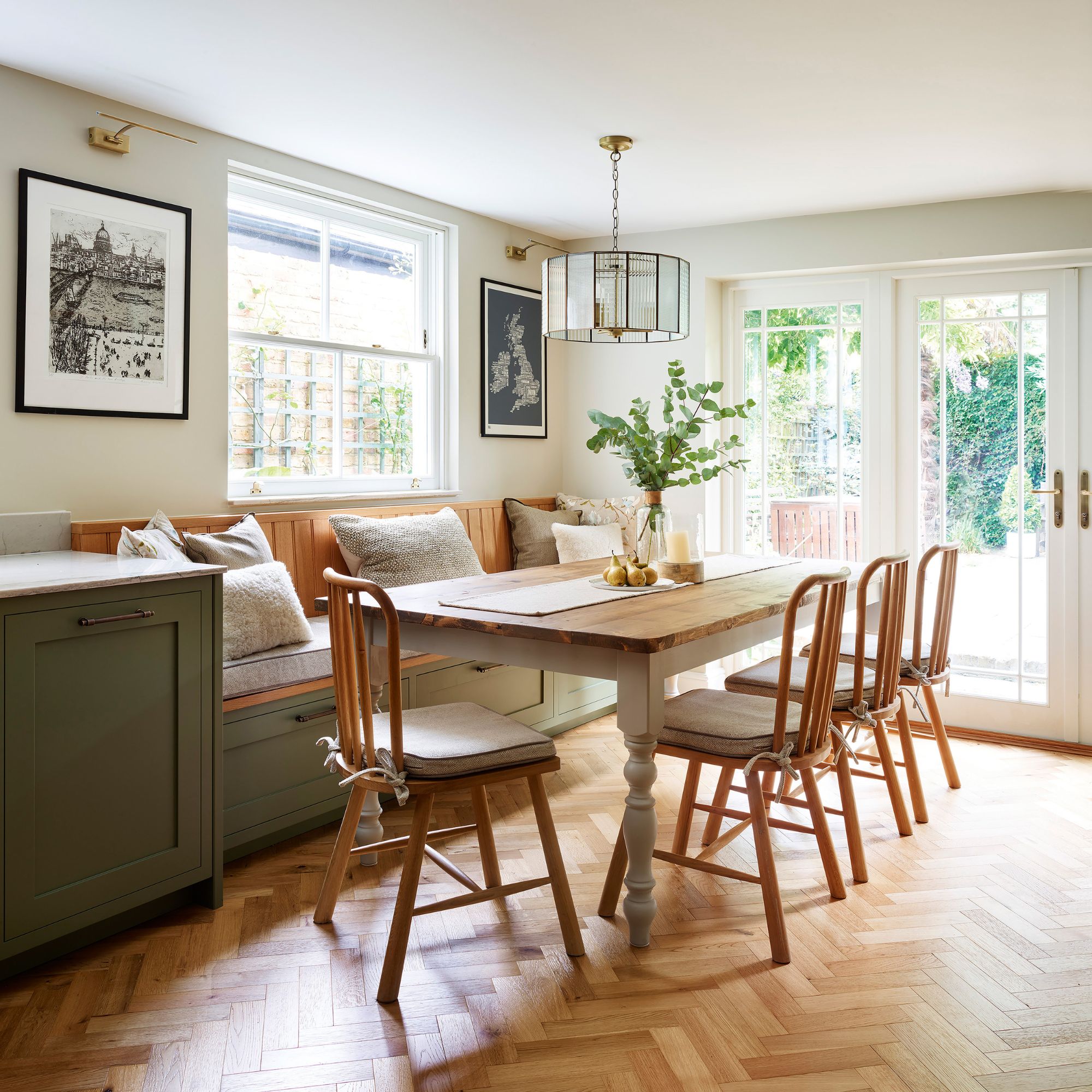
A banquette seating area can be space-hungry, but when it’s designed effectively it can offer plenty of kitchen storage ideas as well as a place to sit at the table. ‘You can never have enough storage in a kitchen, especially if you are working to smaller dimensions,’ states Richard Davonport, managing director of Davonport.
‘Drawers under a banquette seat can hold rarely used or bulky kitchen gadgets, as well as items such as table linens and centrepieces that may be brought out infrequently. Drawers can be a more practical solution than lid-style lift-up access as you don’t need to remove cushions to get to what’s inside.’
Ideal Home's Editor Heather Young installed banquette seating with storage in her new kitchen, and hails it as one of the kitchen design features that make her life easier every day.
Sign up to our newsletter for style inspiration, real homes, project and garden advice and shopping know-how
2. Illuminate with vintage lights
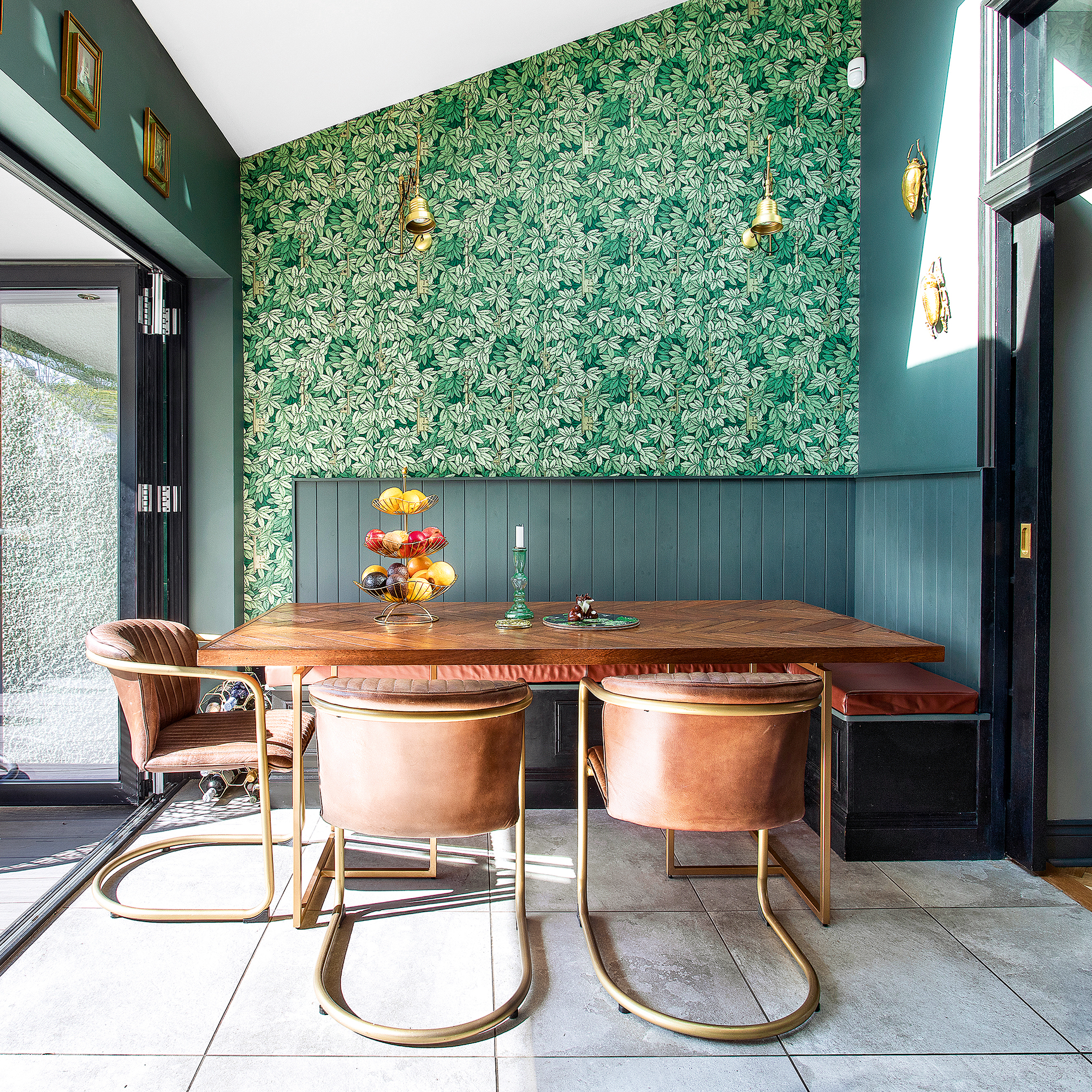
Lighting a banquette requires a deft touch. ‘Whether setting the ambience in a relaxing reading nook or illuminating a banquette seating and table space for dining, working and socialising, go for vintage lights that provide both function and form,' says Chris Miller, co-founder of vintage lighting company Skinflint.
'Statement kitchen lighting ideas such as pendants above a table, or positionable lights, not only light specific tasks but also help to lead the eye to make a banquette the focal point of the room.'
‘Vintage lights are a sustainable design option, and their salvage and restoration story makes for an interesting conversation starter with guests too. ‘
3. Opt for a curved design
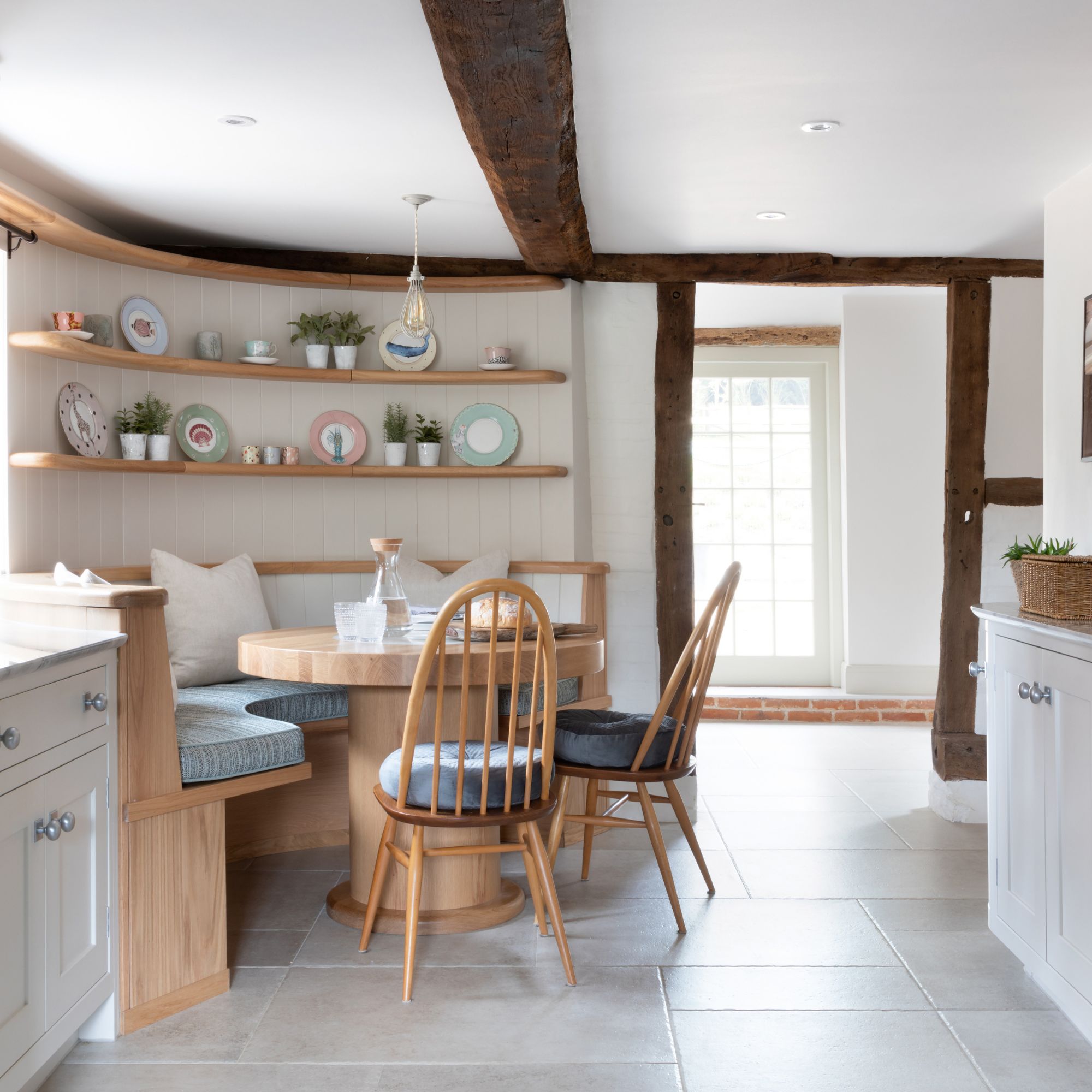
‘Where the walls are uneven, or if there is an awkward corner area with beams or original skirtings, we recommend curved banquette seating around a circular dining table. Curved banquettes can usually accommodate three people comfortably, with chairs on the other side of the table,’ advises Darren Taylor, managing director of Searle & Taylor.
‘For the seat back, curved tongue-and-groove bespoke joinery can be built up to the ceiling and shelving included to make a feature of the space, which can be painted to suit the decor. The curves will immediately soften the look of your kitchen, making it appear cosy and inviting.’
4. Choose a compact design for a small kitchen

Surprisingly more compact than a traditional table and chairs, a banquette is a great addition to the end of a galley kitchen – as shown in this space designed by Neptune.
‘Our bespoke Buckland bench seating can be configured to create a dining nook, with the option of adding storage baskets beneath. Or you might use a ready-made bench that fits comfortably into your space for an economical alternative,’ says Simon Temprell, interior design manager.
‘Seat pads or cushions can add a layer of comfort to the set-up. This kind of seating will keep your kitchen looking streamlined while allowing you to bring in soft furnishings.’
5. Think about upholstery
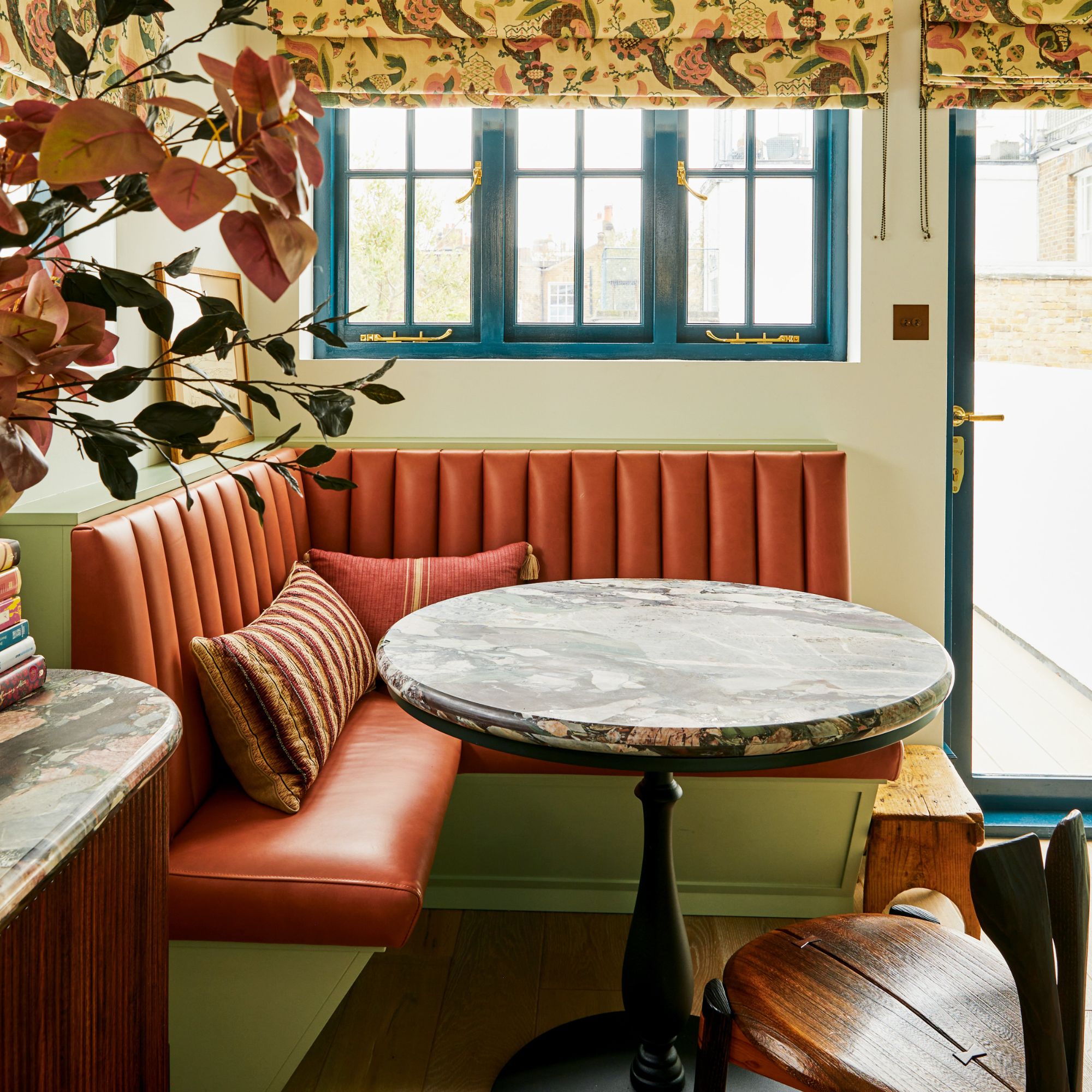
As with any kitchen addition, durability is key. This is especially important when it comes to banquette upholstery. Loose cushions or seat pads with removable covers will be easy to wash, while for fitted seats a cleanable fabric is preferable.
Leather or vinyl is easy to wipe clean but will need treating over time with oils (for leather) or protectants (for vinyl) to prevent cracking. ‘I’d recommend choosing a fabric with in-built stain technology, such as one from our Aquaclean collection,’ says Sophie Clark at Plumbs. ‘These can be easily spot cleaned with just water, and you don’t have to sacrifice on style or fabric feel.’
6. Pair with decorative deatils
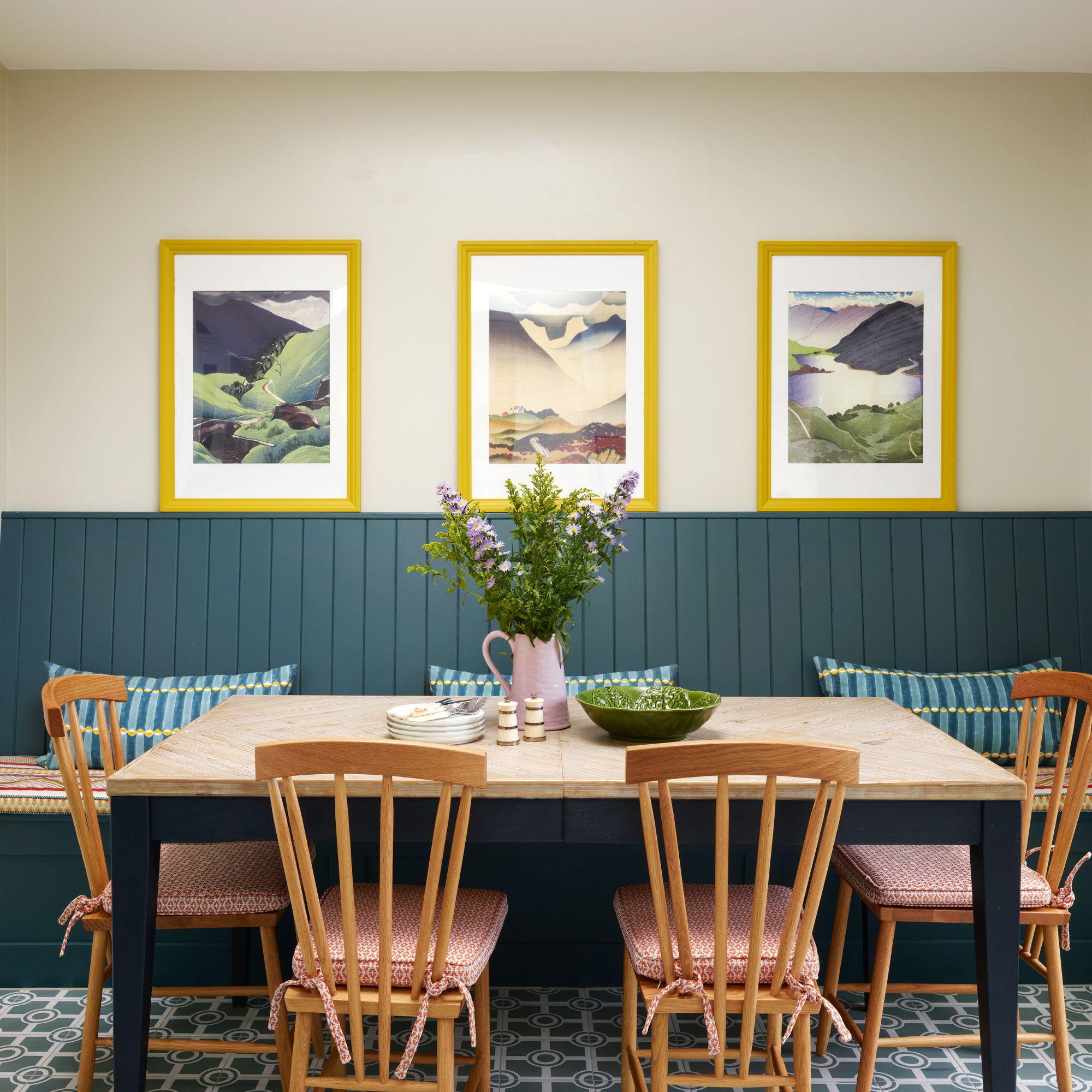
Incorporate gallery wall ideas to create a cosy nook in your kitchen. Here a trio of decorative prints in eye-catching yellow frames provide a beautiful contrast to the blue and pink tones of the scheme.
7. Build a banquette onto your island
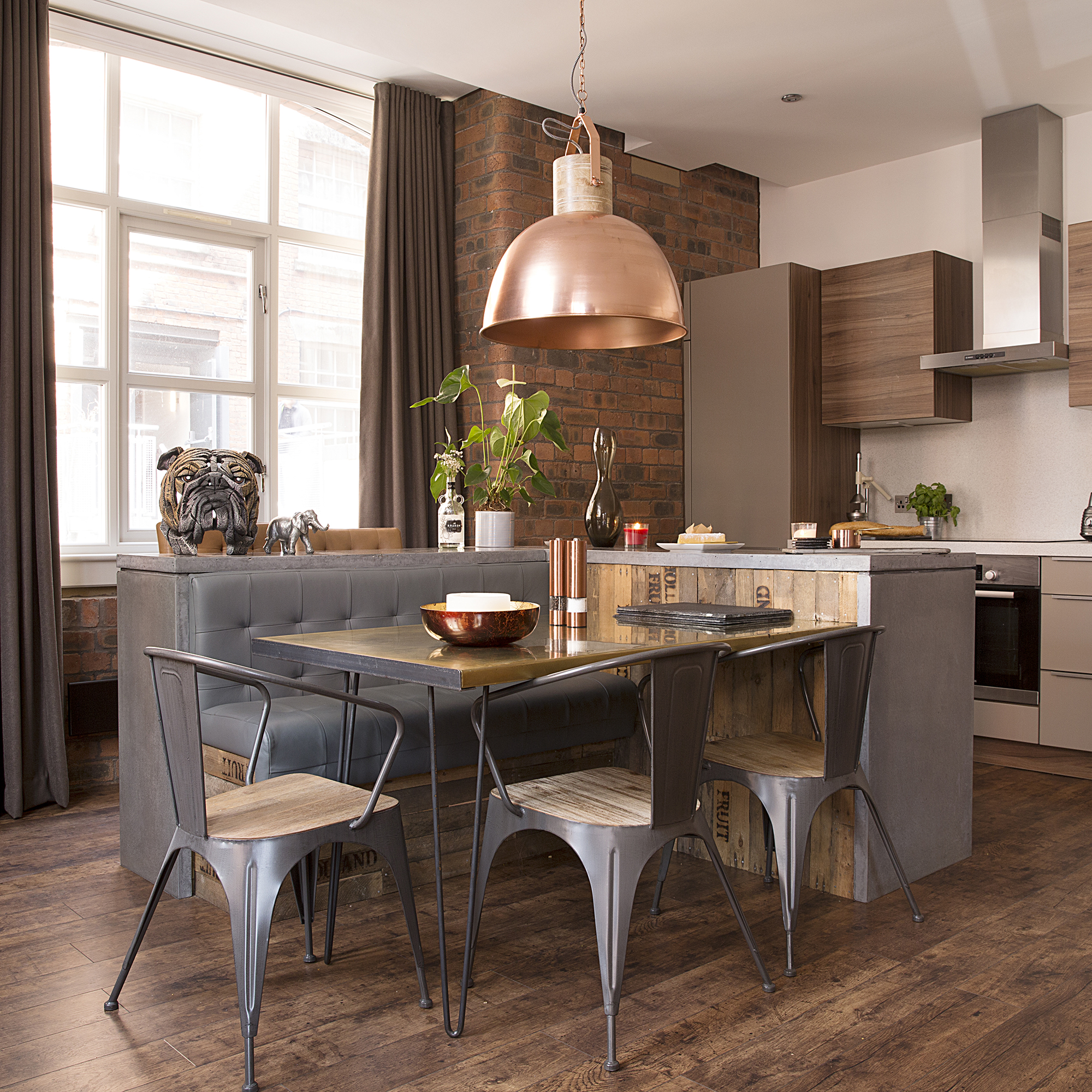
Multifunctional furniture is always a space-saving win, and this island/banquette combo takes top prize for functionality and flair. Providing vital extra prep space in a compact kitchen, this clever kitchen island idea will easily seat five-six diners in a sociable space.
Built-in banquettes can be added to islands of all sizes, you just need to ensure sufficient space to navigate around the island. Make sure to factor in the space when chairs are in use. If there is also a sink or hob on the island worktop, check there is adequate distance between them and the banquette. This is important for safety and cleanliness purposes. Finally, choose upholstered materials carefully. Being closer to food prepping action, they need to be easy to wipe clean and durable.
8. Divide and conquer

Banquette seating isn’t just for small kitchens. It can also be a great option when used to zone large open-plan kitchens. ‘An L-shape banquette that comes out into the room, peninsula-style, is an effective and simple way to divide the room visually,’ says Graeme Smith, Head of Retail and Commercial Design, Life Kitchens.
The generous design of this L-shape banquette allows space within for storage, accessed from the back. This can be used for general kitchen overspill, or crockery and linens to dress the table. Consider bringing seating out into the room to maximise garden views. This can be missed if all seating is hugging the wall facing in one direction.
9. Give banquette seating a colour hit
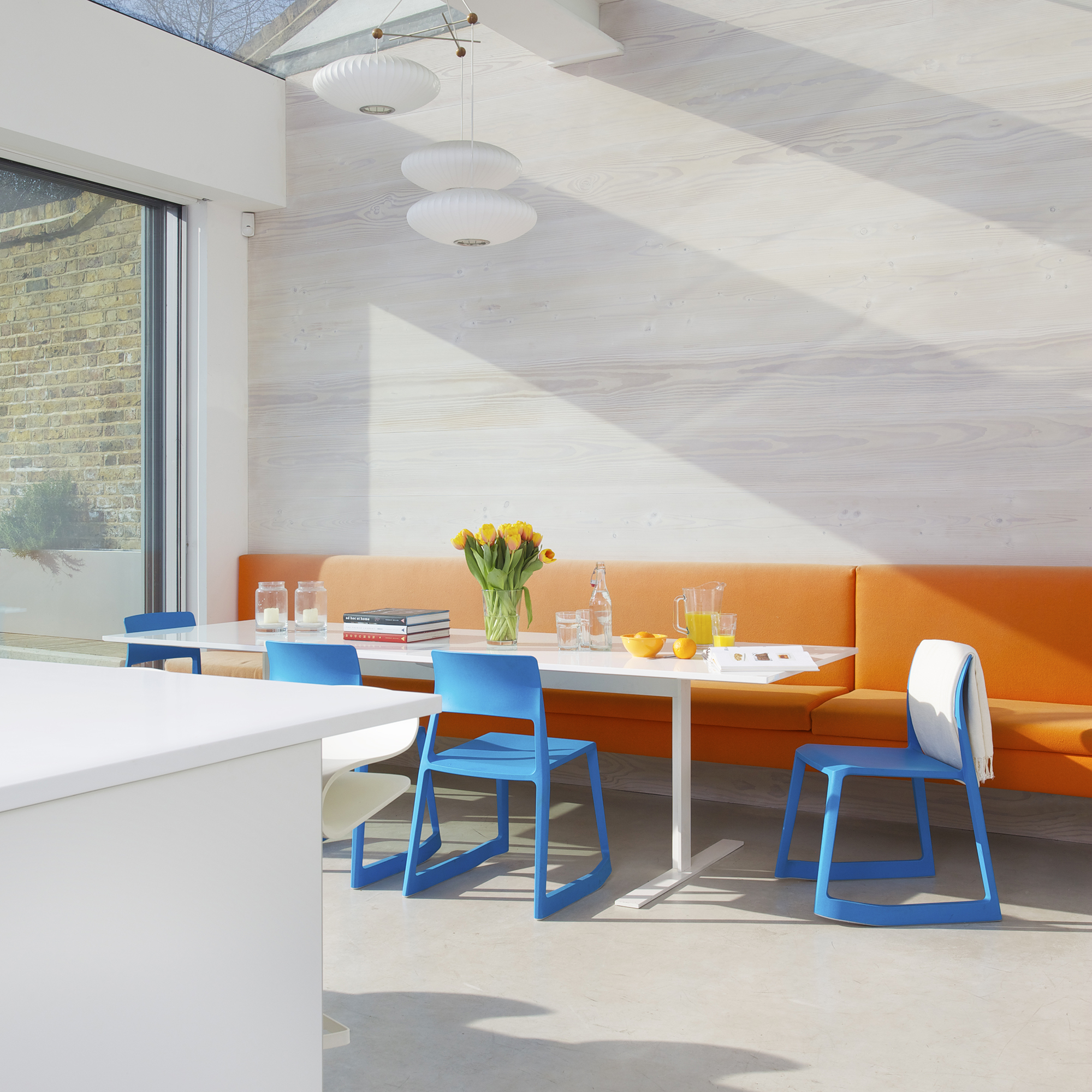
Dial up the colour in a sun-filled spot for a seriously uplifting mood boost no matter what the weather brings. ‘Increasingly, customers are opting for bold, bright colours for their banquettes,'says Richard Moore, design director, Martin Moore. 'These include colour such as mustard yellow, electric blue and zesty orange.'
'Colour helps bring character and interest to the scheme, without overwhelming the space. Luxurious, soft fabrics such as velvet are also proving extremely popular.’ Wall-mounted banquette seating leaves more flooring on show. This is a great visual trick to increase the sense of space.
10. Pull up a stool
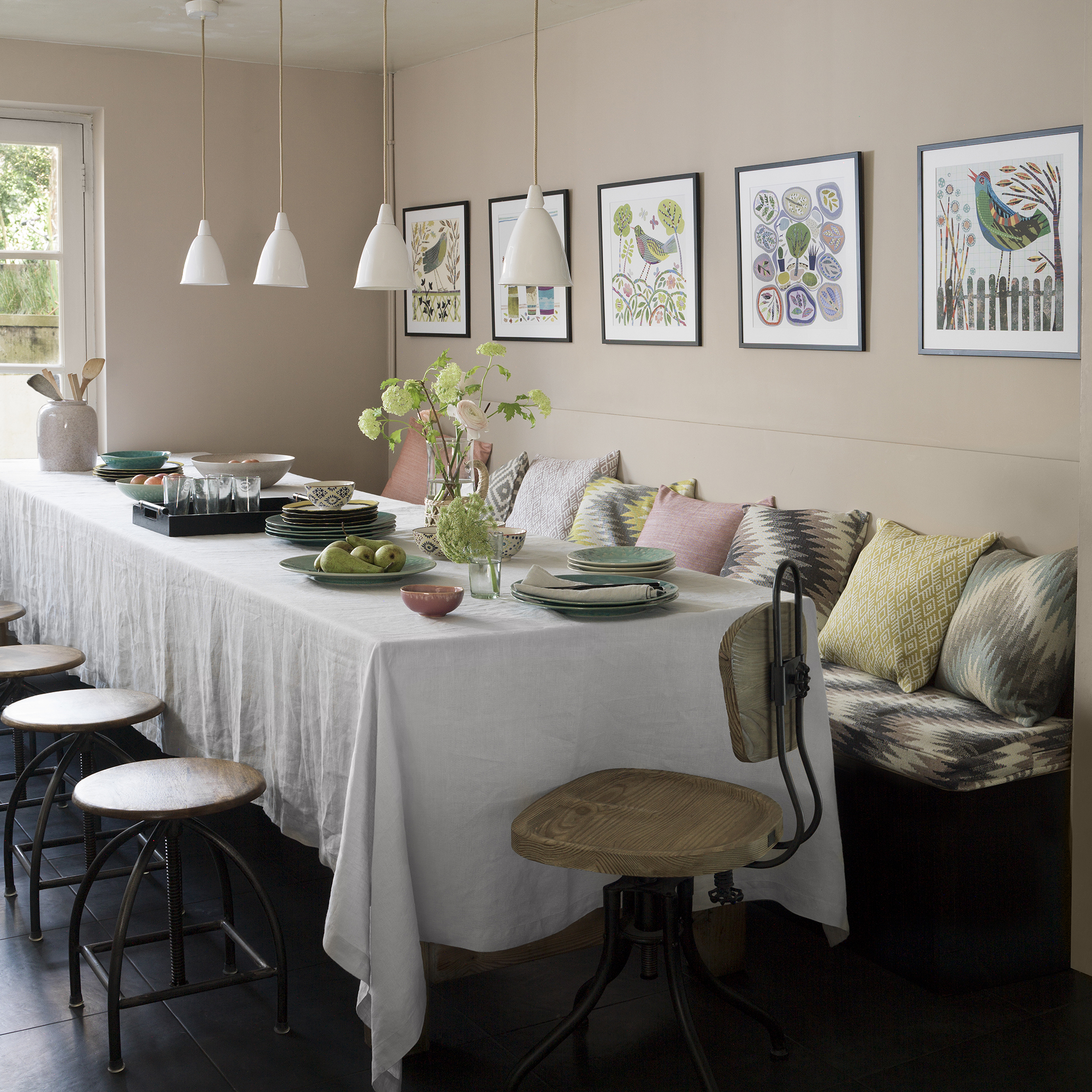
Stools are the way forward if you occasionally need to seat a lot of people. The joy of stools, compared to chairs, is they can be tucked right under the table. This improves the traffic flow through the space. Bear this in mind if your banquette dining is on route to the garden or another busy thoroughfare. A bench can also be tucked under the table and will sit even more guests as they can squish closer together.
A high-capacity banquette dining space is ideal for entertaining crowds in a small kitchen-diner. Before pushing a table up against the wall at one end when banquette seating is installed, think carefully. It will require long-distance shuffling to get everyone seated along the banquette. Then there's another long shuffle if the person on the enclosed end needs to get out. Pop nimble children on the inside, leaving the stools for the adults!
11. Use removable cushions
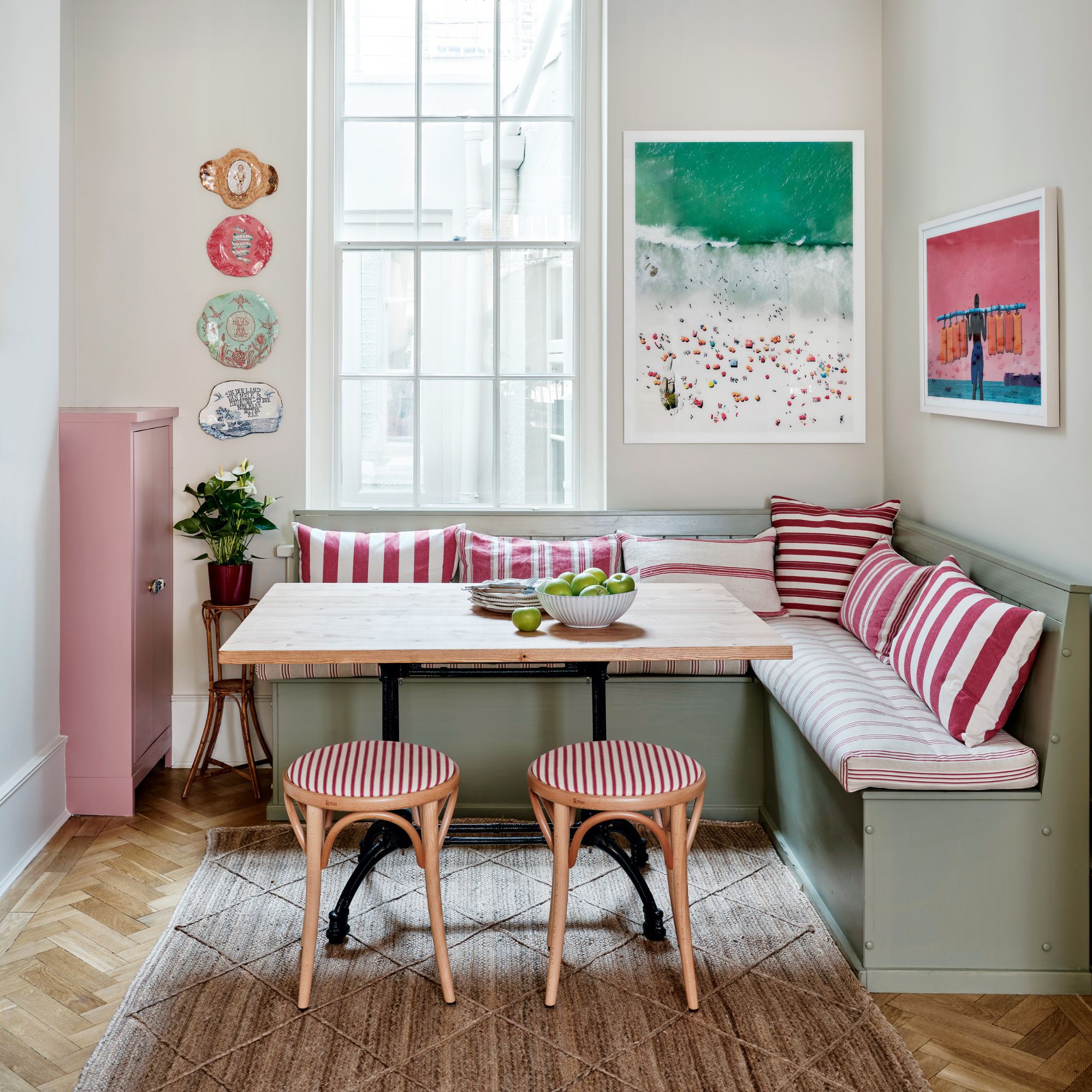
Save on the expense of bespoke upholstery by opting for a simple painted banquette scattered with colourful cushions. Here, solid timber built-in seats are paired with cushion pads and plenty of comfy cushions.
High-density foam is widely considered the best choice for bench seats, as it holds its shape well and is long-lasting. It can be bought off the shelf, or cut to order complete with cover.
Keep your banquette seating area clean and fresh with removable covers that can be machine washed at low temperatures to prevent shrinking.
Tongue and groove panelling with a neat capping strip is a classic technique for protecting the walls behind this style of banquette seating. Paint in eggshell, as it’s a more practical choice compared to an upholstered back, particularly in a busy family home.
12. Go for an easy-access table
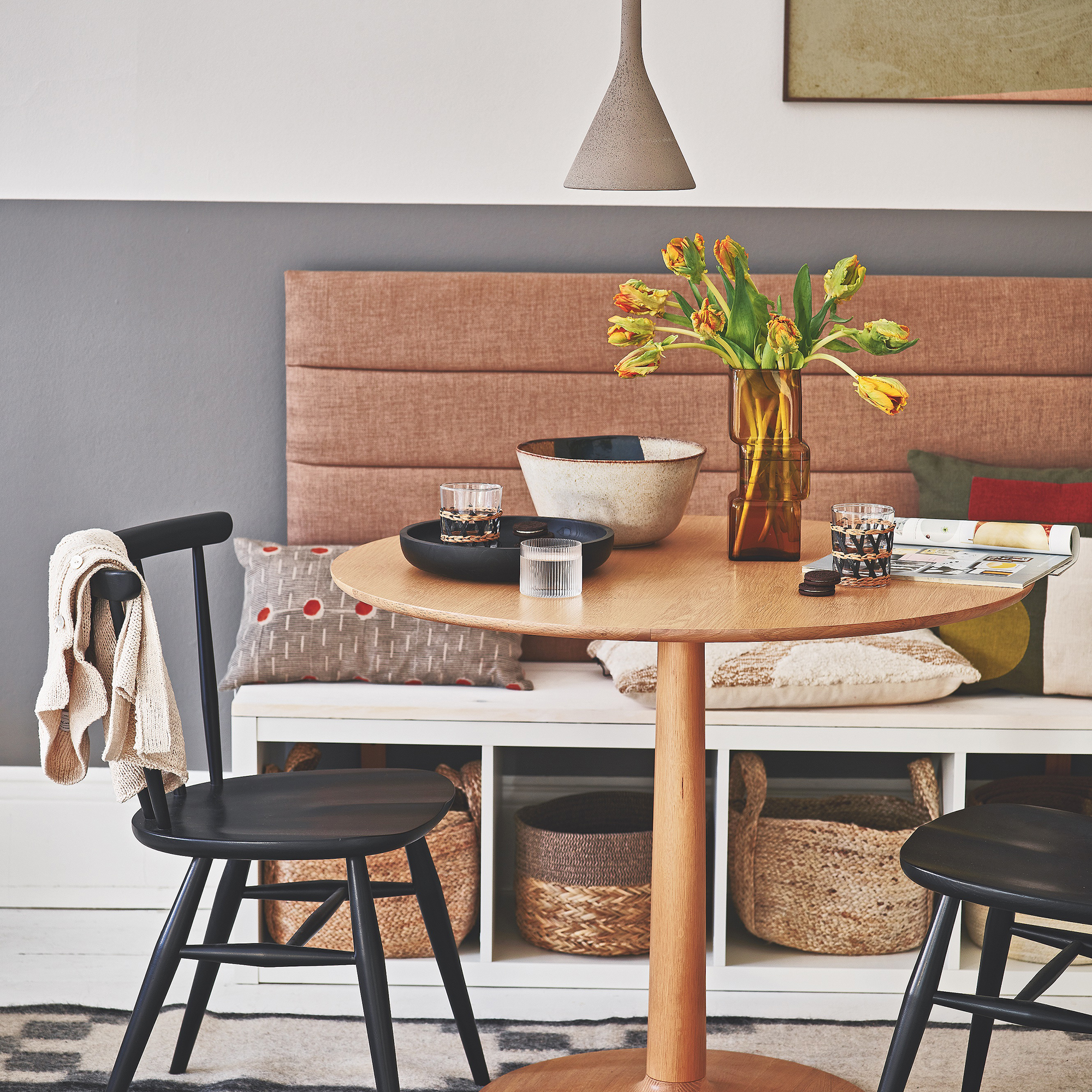
The main downside of using banquette seating for dining is access. If you’ve ever been squished into the back of a booth while eating out, you may well have decided they’re not for you!
Avoid a claustrophobic dining experience, with a smaller table. And make it a round one! The shorter the table, the better your chances of being sat somewhere with a swift exit.
The curves on a round table also make your banquette seating more easily accessible. And as the table is supported centrally, there are no tricky legs to navigate past when you want to sit down. For the best of both worlds, go for a long banquette seat with a small table at one end. This offers plenty of room to relax and the perfect spot for breakfast.
13. Make the most of an awkward niche
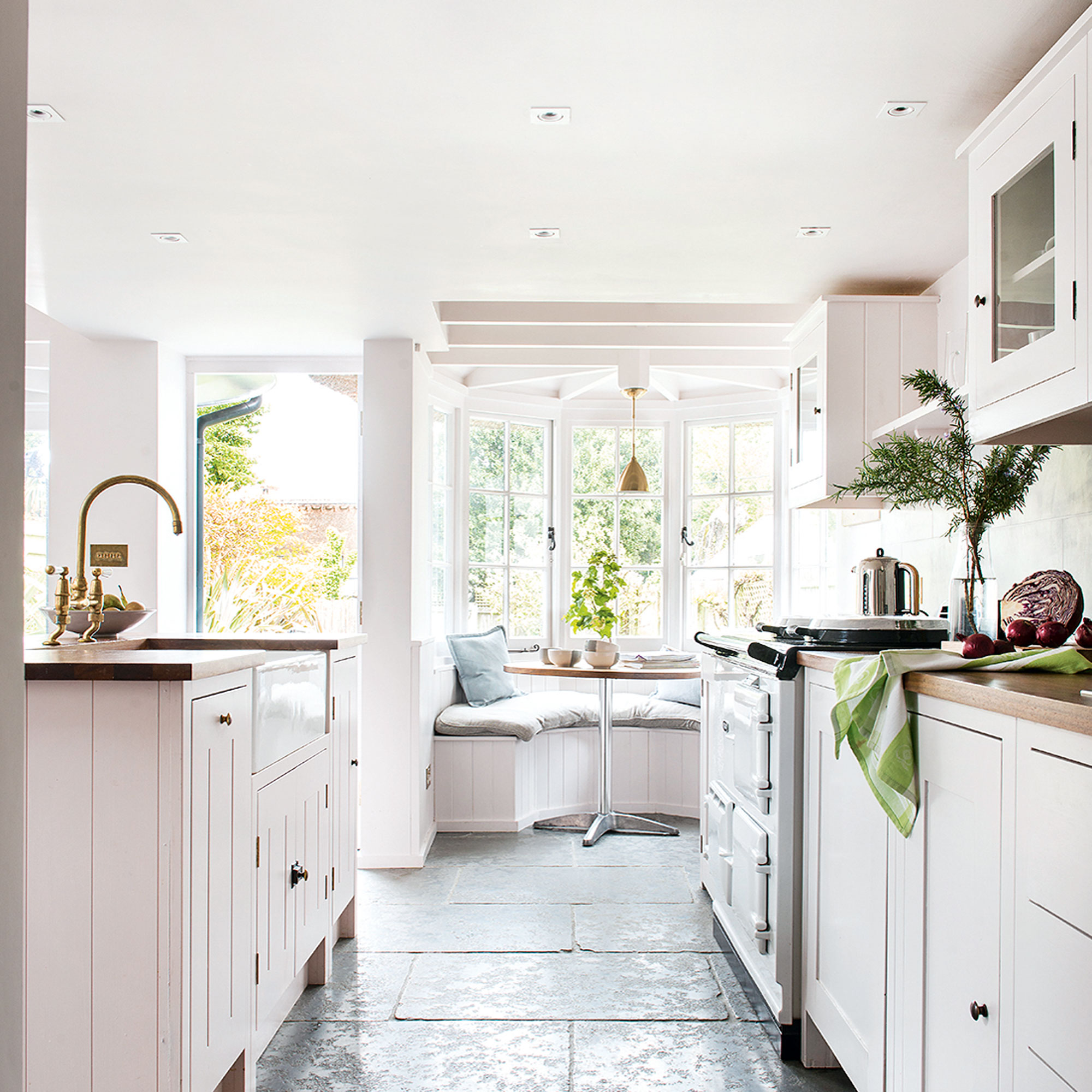
To make space for a dining table with chairs, you should allow at least 90cm between the table and the next piece of furniture or wall. This leaves room to pull chairs back far enough to comfortably sit down. With banquette seating you can reduce that down to as little as 30cm as the seat fits directly onto the wall.
In a small dining niche like this one, allowing space for chairs would have resulted in a much smaller table. Instead, curving banquette seats tight to the wall on all three sides means the table size is far more practical. Diners can enjoy dining in a cosy kitchen booth-style niche that’s perfect for intimate dinners with family and friends.
14. Elevate with design features
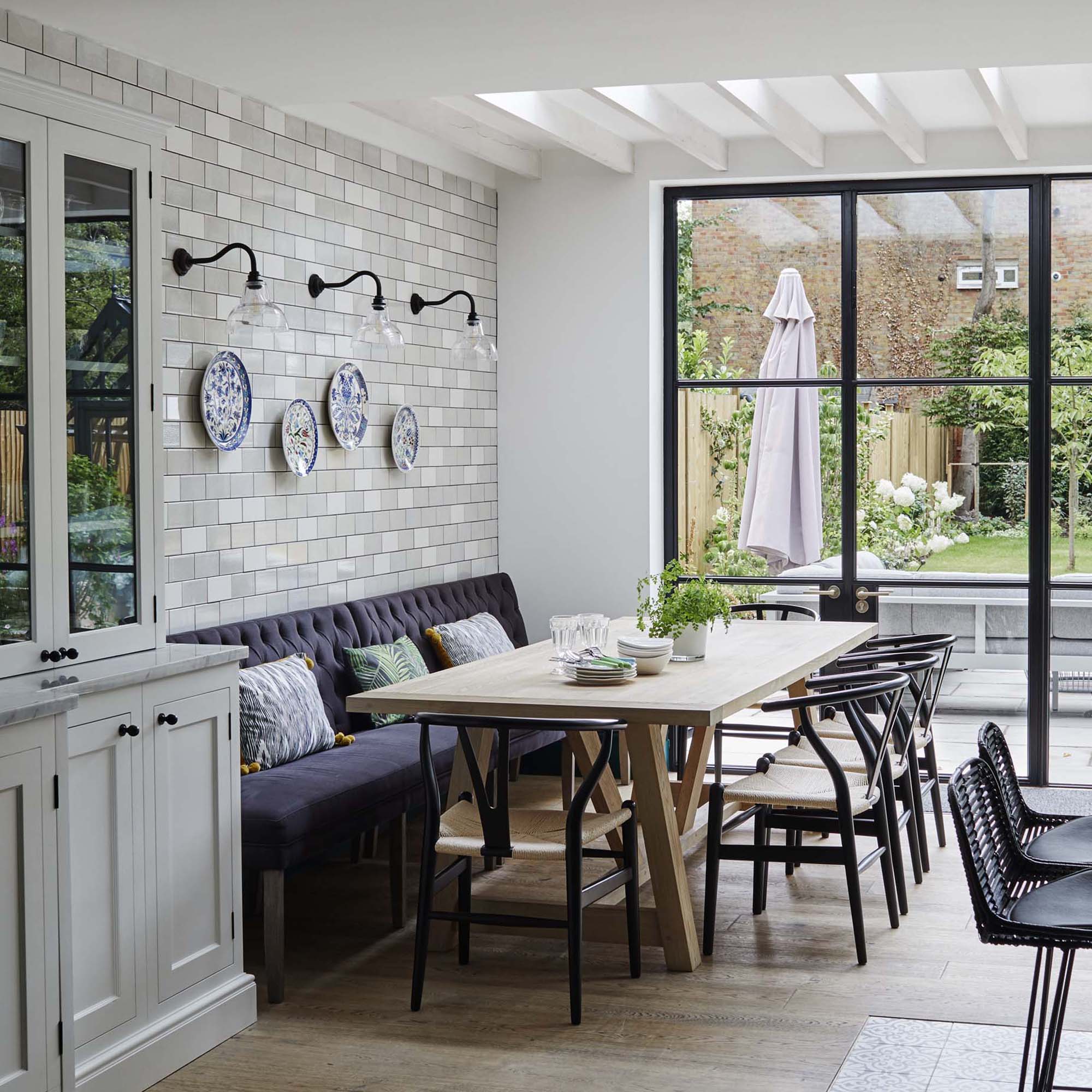
Sure, banquette seating is practical on many levels, but it can also bring a decorative flourish to your living space. A richly upholstered banquette in soft velvet or linen can balance out the harder surfaces in a kitchen. Plus it provides an eye-catching feature that adds colour and texture.
Elevate the design further using creative upholstery techniques, such as fluted, scalloped or button back designs. Other options include contrasting piping and even fringing. Underneath, go for elegant legs to mimic the style of a stylish sofa and give the banquette a lighter, less boxy look.
15. Create a window seat

When wall space is at a premium, windows make great backdrops for banquette seating. Throw on a few comfy cushions to protect your back without obscuring the view. Here, a modern L-shape banquette, made by Blakes London, takes advantage of a large picture window to accommodate more diners. The result is a sociable space that only uses up one wall of the kitchen-diner and includes tonnes of storage in hidden push-touch drawers below.
FAQs
What is banquette seating?
Banquette seating is built-in benches, usually fixed to a wall or other structure. It can’t be picked up and moved in the same way as freestanding chairs. Booth style banquettes have long been popular in restaurants and diners, where higher numbers of customers can be accommodated in reasonable privacy. In the home, they’re also celebrated for their space-saving benefits and sociable, informal dining style.
Banquette seating comes in various forms, including designs with built-in storage, fully-upholstered, partially upholstered and with open legs or fitted plinths. The latter is good for preventing dust and debris from creeping into the dark recesses beneath.
Is banquette seating a good idea?
Nearly always, yes! It’s great for making the most of an awkward nook or snug corner, and, done well, the comfort levels can rival a sofa.
‘Not only do you save space by choosing a banquette, but you can also accommodate more people,' says Jamie Blake, creative director, Blakes London. 'Children can squish together and get much closer than they would on separate chairs. It's perfect for birthday parties and family gatherings.’
The only time banquette seating isn't a smart move is for those who are less able or have mobility issues. Not everyone can physically slide along a banquette seat. However, if you have regular dining chairs opposite, banquette seating becomes much more inclusive.
Can you DIY banquette seating?
Absolutely. The easiest solution is to go for simple banquette seating made from stud framing and plyboard, then painted. Add seat pads and cushions for comfort. You can also use tongue and groove panelling for the back to make it look a little fancier above tabletop level.
There are several really good DIY tutorials on YouTube to get you started but if you can build a simple shelf unit or add panelling to your walls then you should have the skills and tools to make banquette seating.
Upholstered bench seating is a little harder. A simple, rather basic solution would be to use spray adhesive to fix pre-cut foam to plyboard (cut in the shape of the back panel). Then cover in your chosen fabric and tack it behind using a mallet and upholstery tacks. Do the same with the base panel, then fix the base down to your frame and the back panel to the wall above. A gentle slope will increase comfort levels.
Do banquettes save space?
Yes, banquettes do save space. ‘Banquette seating offers a fantastic opportunity to relieve storage pressures in a busy home,’ says interior designer Clare Gaskin. ‘Consider what you’d like to store and, most importantly, how often you need to access it.’
In this kitchen-diner, drawers under the banquette seat cater for rarely used kitchen gadgets and bulkier toys. Don’t forget children will have no trouble getting under a table to find their treasures!
‘We’re big fans of drawers, rather than lid-style lift-up bench storage, when we design banquette seating,’ says Clare. ‘The contents are more accessible, and there's no need to remove cushions to access what you need.’ Here, two drawer units frame the seating bench to deliver storage for items in frequent use.

Linda Clayton is a professionally trained journalist, and has specialised in product design, interiors and fitness for more than two decades. Linda has written for a wide range of publications, from the Daily Telegraph and Guardian to Homes & Gardens and Livingetc. She has been freelancing for Ideal Home Magazine since 2008, covering design trends, home makeovers, product reviews and much more.
- Holly ReaneyContent Editor